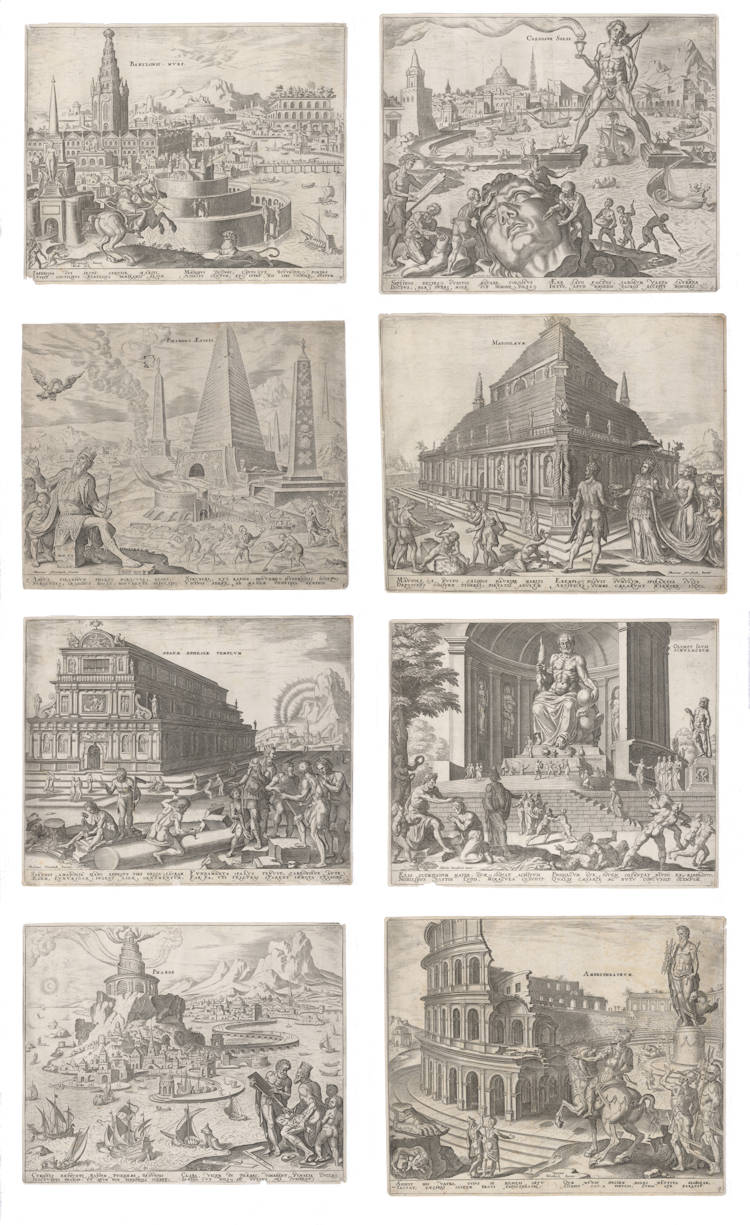Leen Helmink Antique Maps & Atlases
www.helmink.com
Maarten van Heemskerck - [ The Seven Wonders of the World and the Ruins of the Coliseum ]
Certificate of Authentication
This is to certify that the item illustrated and described below is a genuine and
original antique map or print that was published on or near the given date.
Dr Leendert Helmink, Ph.D.

Cartographer
Maarten van Heemskerck
First Published
Antwerp, 1572
This edition
Antwerp, first states of 1572
Size
21.3 x 26.2 cms
Technique
Copper engraving
Stock number
19101
Condition
excellent
Description
Complete set of the Wonders of the World, engraved by Philips Galle in 1572, after designs by Maarten van Heemskerck. Eight engravings were part of this series. Celebrated monuments that were labeled as Wonders of the World have been known since antiquity.
For a detailed treatment of each of the wonders, and Maarten van Heemskerck's versions of them, see Wonders of the World.
Condition
First states with the publishers address of Philips Galle, before that of Theodor Galle in state II and III. A complete homogeneous set in mostly excellent, even impressions of the first state, trimmed to the plate mark, usually with tread margins around it. Occasional small defect to the corners or small repaired defect along the invisible flattened vertical middle fold.
Rarity
Lacking in nearly every collection. Complete homogeneous sets are of highest rarity. Very few complete sets have come to the market in modern times.
Summary
Legendary and iconic engravings by Philip Galle of the seven wonders of the ancient world, after drawings by Maarten van Heemskerck. Van Heemskerck added the Colosseum in Rome as the eight wonder.
Monumenta Cartographica Neerlandica Volume VI, Map 1
Willem Jansz [Blaeu] 1606 map of the World on Mercator's projection
Blaeu's 1606 world map is framed on all sides by decorative borders. The top border consists of the SEPTEM PLANETA with illustrations of the planet gods of classical mythology in seven oval medallions: the moon goddess LUNA as the goddess of the hunt; MERCURIUS as the god of trade; VENUS as the goddess of love; the sun god SOL; MARS as the god of war; the King of gods IUPITER, with his thunderbolts; and SATURNUS as the god of growth.
These seven figures of gods are counterbalanced by the lower border in the SEPTEM MIRABILIA MUNDI where seven medallions contain depictions of the Seven Wonders of the Ancient World:
MURUS BABYLONIÆ, the wall of Babylon;
COLOSSUS, the gigantic statue above the harbour entrance of Rhodes;
PYRAMIDES, the Egyptian pyramids;
MAUSOLEUM, the tomb of King Mausolos in Halicarnassus;
DIANÆ TEMPLUM, the Temple of Artemis at Ephesus;
IUPITER OLYMPICUS, the statue of Zeus of Phidias at Olympia; and
PHAROS, the lighthouse of Alexandria.
The side borders are divided into four rectangular segments, with the four elements (QUATUOR ELEMENTA) on the left and the four seasons (QUATUOR ANNI TEMPESTATES) on the right.
The decorative borders of the world map were not derived from artists' designs specially ordered by the publisher. On the contrary, Blaeu had a compilation made from various series of prints which had already been published by famous Dutch artists at the end of the sixteenth century. A balanced composition and elegant ornamentation make this world map one of the small masterpieces of the seventeenth century.
(Gunter Schilder)
Monumenta Cartographica Neerlandica Volume IV
Map of the World in folio size, drawn on Mercator's projection, 1606
In the lower border are the Seven Wonders of the Ancient World as counterparts of the seven gods representing the planets. A series of prints also served as a model for them, namely, seven of the eight 1572 engravings by Filips Galle after Maarten van Heemskerck. Van Heemskerck (1498-1574) confined himself in particular to issuing very accurate, detailed sketches, which were then engraved in copper by various able engravers, such as Dirck Volkertsz Coornhert, Filips Galle, Herman Jansz Muller, Cornelis Cort. Inspired by Italian humanism from the sixties on, Van Heemskerck began to emphasize instructional subjects with, for example, an informative series on the seven planets, the four seasons, the four temperaments, the wonders of the world, and illustrations from history. In carrying out these projects, he benefited from a collaboration with the humanist Hadrianus Junius (1511-1575), who provided numerous prints with Latin explanations in verse.
The rediscovery of ancient writers such as Herodotus, Plinius, and Strabo brought the wonders of the world to people's notice again. Van Heemskerck is credited with being the first to make a series of sketches of all Seven Wonders of the World. In this series the artist still added the Colosseum in Rome as the eighth wonder of the world. The sketches of the colossus of Rhodes, the temple of Diana in Ephesus, the walls of Babel, the lighthouse of Alexandria and the Colosseum in Rome have been preserved (Courtauld Institute, London).
Two years later these drawings, made in 1570, were engraved in copper by Filips Galle, and served as models for the engraver of Blaeu's map of the world.
(Gunter Schilder)